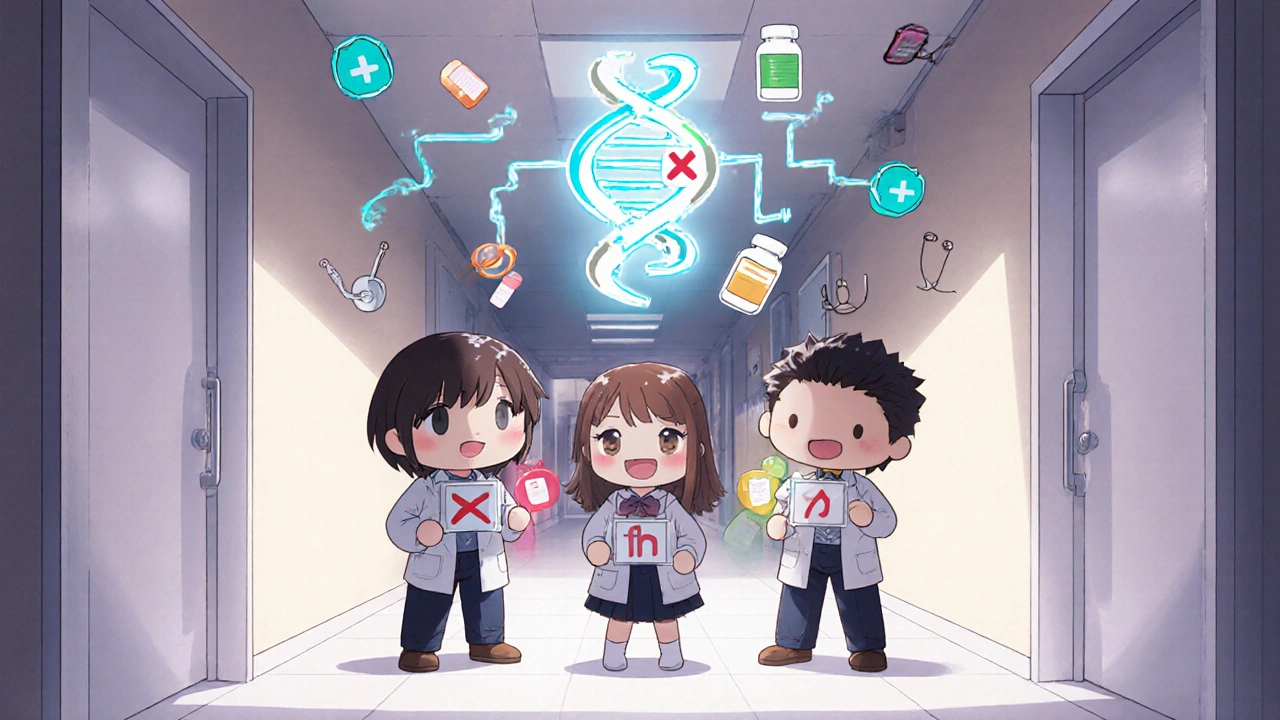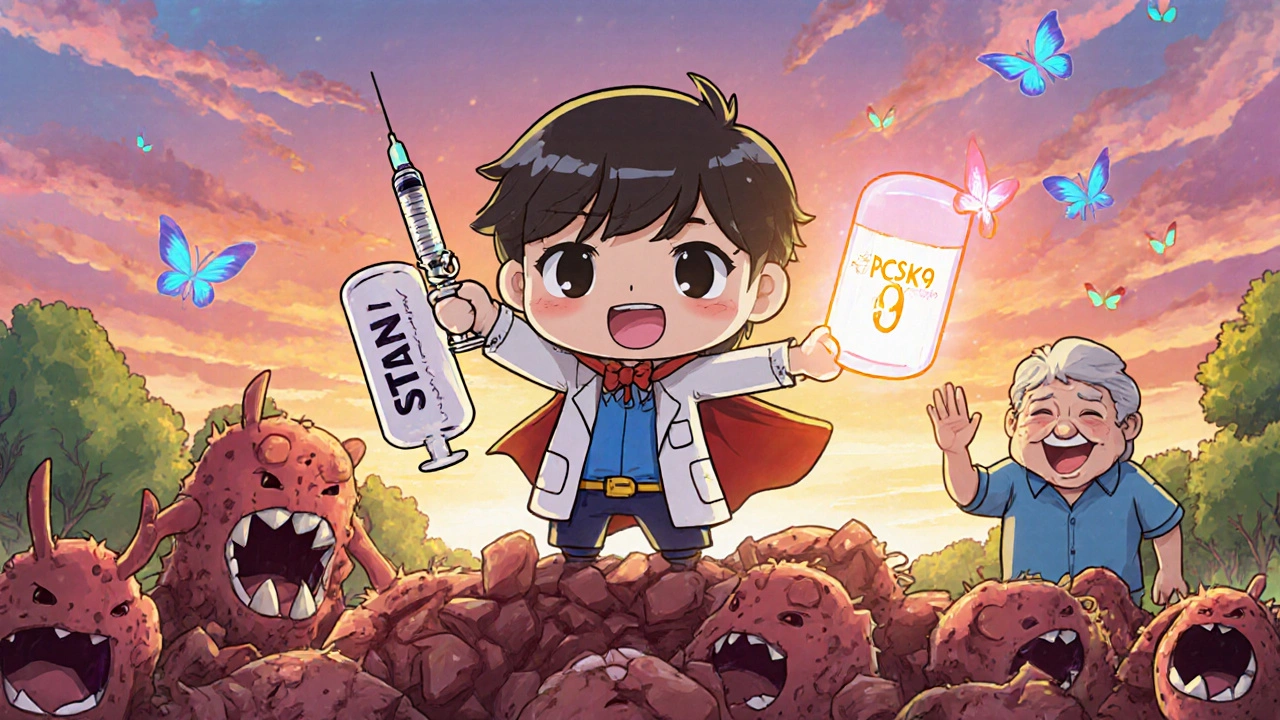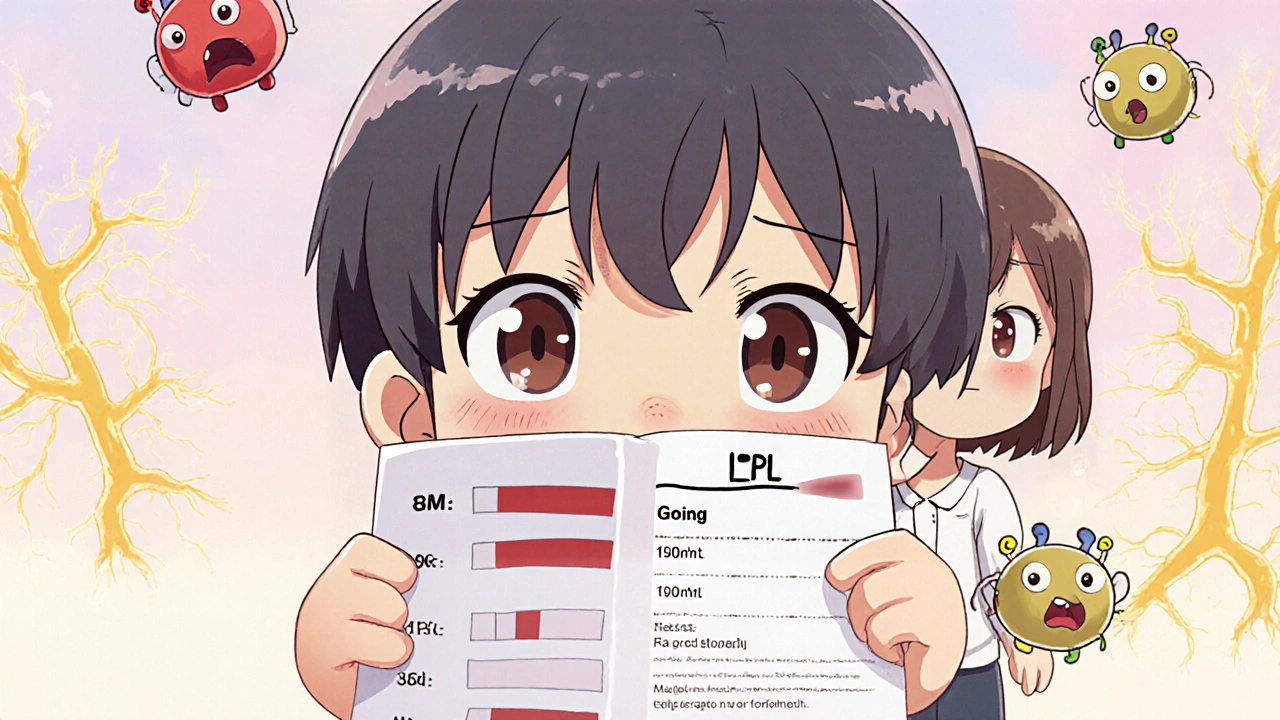Familial hypercholesterolemia isn’t just high cholesterol. It’s a genetic time bomb. People born with this condition have LDL cholesterol levels so high from day one that their arteries start clogging long before they hit middle age. Without treatment, a man with untreated FH has a 50% chance of having a heart attack before he’s 50. A woman? Nearly 30%. And yet, up to 94% of people with this condition don’t even know they have it.
What Familial Hypercholesterolemia Really Means
Familial hypercholesterolemia (FH) is inherited. If one parent has it, each child has a 50% chance of getting it too. It’s not caused by eating too much butter or skipping the gym. It’s a broken gene - usually in the LDL receptor, PCSK9, or apoB - that stops the liver from cleaning cholesterol out of the blood. The result? LDL levels that can hit 190 mg/dL or higher in adults, and sometimes over 400 mg/dL in the rare homozygous form.
That’s not the same as high cholesterol from poor diet. In FH, cholesterol builds up silently, year after year. By age 20, some people already have visible plaques in their arteries. By 30, heart attacks aren’t rare. The average age of diagnosis in the U.S. is 44 - but the damage started decades earlier.
Why Most People Never Get Diagnosed
Here’s the problem: many people with FH look perfectly healthy. No symptoms. No chest pain. No warning signs. Unlike the severe form (homozygous FH), which can cause visible lumps on tendons or a white ring around the cornea, heterozygous FH - the most common type - often hides in plain sight.
Doctors don’t always test for it. Most people only find out after a heart attack, stroke, or sudden death in the family. A 2022 study in Circulation found that only 2.9% of diagnosed FH patients in the U.S. had their relatives screened. That means for every person diagnosed, dozens of others - parents, siblings, kids - are left in the dark.
Even when cholesterol is checked, it’s often dismissed as "just high." Pediatricians rarely screen kids between ages 9 and 11, even though the American Heart Association recommends it. A 2023 survey showed only 12% of U.S. pediatricians routinely check cholesterol in children - despite the fact that FH shows up clearly by age 5.
The Two Keys to Detection: Universal Screening and Cascade Screening
There are two proven ways to find FH before it’s too late: universal screening and cascade screening.
Universal screening means checking every child’s cholesterol between ages 9 and 11 - no symptoms needed. It’s simple. A fasting lipid panel costs less than $50. If LDL is above 160 mg/dL in a child, FH is strongly suspected. In adults, anything over 190 mg/dL should trigger further investigation. This isn’t optional. It’s the standard of care. And yet, in the U.S., it’s the exception.
Cascade screening is how you find the rest. Once someone is diagnosed, you test their first-degree relatives: parents, siblings, kids. Then, if one of them has it, you test their relatives too. Because FH is autosomal dominant, each generation has a 50% chance of inheriting it. One diagnosis can uncover an entire family at risk.
The Netherlands has been doing this since the 1990s. They’ve found over 18,000 cases. Their diagnosis rate? Around 30%. In the U.S.? Just 6-10%. The difference? Systematic programs. National registries. Insurance coverage for genetic testing. In countries without these, most cases stay hidden.

How Diagnosis Works: Genetics, Criteria, and Tools
There’s no single test. Diagnosis uses a mix of blood work, family history, physical signs, and sometimes DNA testing.
The Dutch Lipid Clinic Network (DLCN) criteria is the most trusted tool. It gives points for LDL levels, family history of early heart disease, personal history of early heart events, and physical signs like tendon xanthomas. A score of 6+ means definite FH. 3-5? Probable. Below 3? Unlikely.
Genetic testing is the gold standard. Finding the exact mutation confirms the diagnosis and makes cascade screening faster - you can test relatives with a simple blood or saliva test instead of repeating cholesterol panels. But in the U.S., insurance often denies it unless the person has extremely high cholesterol or a strong family history. In the UK and Netherlands, it’s routine.
Now, machine learning is stepping in. A 2023 study in JAHA showed AI models analyzing electronic health records - age, sex, LDL, family history - could spot FH cases with 92% accuracy. That’s better than most clinical tools. Hospitals using these algorithms are finding cases 39% more efficiently.
Aggressive Treatment: It’s Not Optional
Once diagnosed, treatment must be aggressive - and early. Waiting until a heart attack happens is unacceptable.
Statins are the first line. High-intensity ones like atorvastatin or rosuvastatin. For kids as young as 8, statins are safe and effective. Studies show starting statins in childhood can reduce heart attack risk by up to 75% over their lifetime.
But many people need more. That’s where ezetimibe and PCSK9 inhibitors come in. PCSK9 drugs like evolocumab and alirocumab can lower LDL by 60% or more. And now there’s inclisiran, a twice-yearly injection that works differently - it silences the PCSK9 gene at the RNA level. It’s a game-changer for adherence.
Guidelines are clear: aim for at least a 50% drop in LDL from baseline. For adults, target LDL below 100 mg/dL. For kids, below 135 mg/dL. In severe cases, LDL needs to be under 70. That often means combining three drugs.
And it works. A landmark study from the Netherlands showed that people with FH who started statins before age 10 had the same life expectancy as the general population. No reduction. No early death. Just a normal life.

Why This Isn’t Happening Everywhere
Why are we still missing so many cases? Three big reasons:
- Lack of awareness. Many doctors still think high cholesterol is lifestyle-related. They don’t ask about family history. They don’t test kids.
- Access to specialists. There’s one lipid specialist for every 1.5 million people in the U.S. Most primary care doctors don’t know how to manage FH.
- Insurance barriers. Genetic testing, PCSK9 inhibitors, and even high-dose statins are often denied or require prior authorization. For low-income families, the cost is prohibitive.
Meanwhile, high-risk groups are being ignored. Afrikaners, French Canadians, Lebanese Christians, Ashkenazi Jews - all have much higher FH rates. Yet screening programs rarely target them.
The Cost of Doing Nothing
The CDC estimates that without action, 250,000 Americans will die prematurely from undiagnosed FH over the next decade. That’s more than the population of Cleveland.
But here’s the good news: cascade screening alone could prevent 180,000 of those deaths. The cost? About $13,500 per quality-adjusted life year gained. That’s far below the $50,000 threshold most health systems use to call something cost-effective. In fact, it’s cheaper than screening for colon cancer or breast cancer.
And it’s not just about saving lives. It’s about saving years - decades - of healthy life. A person with FH who gets treated early can retire, travel, raise kids, and grow old without heart disease holding them back.
What You Can Do
If you’ve had a heart attack before 55 (men) or 60 (women), or if close relatives have, get tested. Ask for a lipid panel. Ask about FH.
If you’re a parent, ask your child’s doctor for a cholesterol check at age 9 or 10. Don’t wait for symptoms. Don’t assume it’s not necessary.
If you’ve been diagnosed with FH, get your parents, siblings, and kids tested. One test could save multiple lives.
And if your doctor says, "We don’t screen for that," push back. Point them to the American Heart Association’s 2024 guidelines. Tell them about cascade screening. Demand action.
Familial hypercholesterolemia isn’t rare. It’s just hidden. And it’s deadly - unless we find it early and treat it hard. The tools are here. The science is clear. What’s missing is the will to act.

11 Comments
Nosipho Mbambo
Wow, this is insane… I had no idea FH was this common, and yet… nobody talks about it? My uncle died at 47. They said "heart attack"… but no one ever tested anyone else. Now I’m scared to get my kids checked. What if I’m carrying it too? 😳
Katie Magnus
Okay but like… why are we even talking about this? It’s just cholesterol. People used to live fine with high cholesterol before all these meds and screenings. Maybe we’re overmedicalizing normal biology? 🤷♀️
King Over
My dad had FH. Diagnosed at 52 after a triple bypass. He’s alive now on three drugs. But we didn’t know until it was too late. Kids should get tested. Period.
Johannah Lavin
THIS. THIS. THIS. 🙌 I’m a nurse and I’ve seen too many young people drop from this. My cousin was 28, no symptoms, no warning… just… gone. If you have a family history, GET TESTED. It’s not scary. It’s life-saving. And if your doc says "it’s just high cholesterol," find a new doc. 💪❤️
Ravinder Singh
As someone from India, I’ve seen this in my own family - my brother had LDL over 400 at 19. We didn’t know it was genetic. We thought it was junk food. Turns out, his dad had silent heart disease at 40. Now I push every relative to get lipid panels. Cascade screening isn’t fancy - it’s family love in action. 🇮🇳❤️
Russ Bergeman
So… you’re saying we should test EVERY kid? At 9? For a condition that only affects 1 in 250? That’s ridiculous. We’re turning healthcare into a guessing game. And PCSK9 inhibitors cost $14,000 a year? Who’s paying? Not me.
Dana Oralkhan
My mom was diagnosed with FH after my brother’s heart attack at 31. She’s 62 now, on statins, ezetimibe, and inclisiran. She’s hiking, traveling, cooking for grandkids. It’s not a death sentence. It’s a wake-up call. And if you’re reading this and you’re scared - you’re not alone. But you’re not powerless either.
Jeremy Samuel
fh? more like fhake. they just wanna sell you drugs. i got my cholesterol checked once and they freaked out over 210. i eat avocado and yoga. i’m fine.
Destiny Annamaria
As a Black woman in the U.S., I’ve never seen a doctor even ask about family heart history. We’re told to "eat less grease" - but no one ever mentions genetics. My grandma died at 45. My mom had a stent at 50. I’m getting my kids tested next week. No more silence.
Ron and Gill Day
Oh wow, another "save the world with statins" article. Let me guess - you’re either a pharma rep or a doctor who makes commission off prescriptions. The real problem? Overdiagnosis. You’re turning healthy people into patients. Let nature take its course.
Alyssa Torres
My brother’s 10-year-old daughter was diagnosed last year. She’s on a low-dose statin. She’s in soccer. She loves ice cream. She’s thriving. This isn’t about fear - it’s about giving kids a shot at a full life. And if you’re a parent reading this? Ask for the test. Don’t wait. Don’t assume. Just ask. ❤️